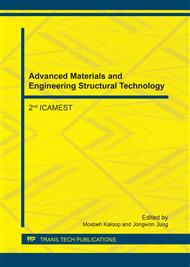[1]
A. Kapura, chemistry of flame retardants aging of n-methylol-3- dimethoxyphosphorylpropionamide and commercial flame retardants for fabrics containing this substance. Fire Sci. 14 (1996) 169-185.
DOI: 10.1177/073490419601400301
Google Scholar
[2]
R. Aenishanslin, C. Guth, P. Hofmann, A. Maeder, H. Nachbur, A new chemical approach to durable flame retardant cotton fabric, Textile Res. J. 39 (4) (1969) 375-381.
DOI: 10.1177/004051756903900413
Google Scholar
[3]
D. Edward, V. Sergei, D. Levchik, Flame retardants in commercial use or development for textiles, J. Fire Sci. 26 (2008) 243.
DOI: 10.1177/0734904108089485
Google Scholar
[4]
V. Bischof, D. Katović, D. Kocijančić, Performance of FR bonding system consisting of MDPA and citric acid. Proceedings of AATCC International Conference (2010) Atlanta.
Google Scholar
[5]
J. F. Fowler, S. M. Skinner, D. V. Belsito, Allergic contact dermatitis from formaldehyde resins in permanent press clothing: an underdiagnosed cause of generalized dermatitis, J. Am. Acad. Dermatol. 27 (1992) 962-968.
DOI: 10.1016/0190-9622(92)70295-q
Google Scholar
[6]
International Agency for Research on Cancer, Monographs on the evaluation of carcinogenic risks to humans, 88 (2006) 1-280.
Google Scholar
[7]
S. Yasin, N. Behary, S. Giraud, A. Perwuelz, In situ degradation of organophosphorus flame retardant on cellulosic fabric using advanced oxidation process: a study on degradation and characterization, Polym. Degrad. Stab. 126 (2106) 1-8.
DOI: 10.1016/j.polymdegradstab.2015.12.005
Google Scholar
[8]
H. Zhang, H. J. Choi, C. P. Huang, Treatment of landfill leachate by Fenton's reagent in continuous stirred tank reactor, J. Hazard. Mater. 136(3) (2006) 618-623.
DOI: 10.1016/j.jhazmat.2005.12.040
Google Scholar
[9]
N. Kang, D. S. Lee, J. Yoon, Kinetic modeling of Fenton oxidation of phenol and monochlorophenols, Chemosphere, 47(9) (2002) 915-924.
DOI: 10.1016/s0045-6535(02)00067-x
Google Scholar
[10]
J. H. Ramirez, F. M. Duarte, F. G. Martin, C. A. Costa, L. M. Madeira, Modelling of the synthetic dye Orange II degradation using Fenton's reagent: From batch to continuous reactor operation, Chem. Eng. J. 148(2-3) (2009) 394-404.
DOI: 10.1016/j.cej.2008.09.012
Google Scholar
[11]
J. H. Sun, S. P. Sun, H. M. Fan, H. Q. Guo, L. P. Qiao, R. X. Sun, A kinetic study on the degradation of p-nitroaniline by Fenton oxidation process, J. Hazard. Mater. 148 (1-2) (2009) 172-177.
DOI: 10.1016/j.jhazmat.2007.02.022
Google Scholar
[12]
I. Gulkaya, G. A. Surucu, F. B. Dilek, Importance of H2O2/Fe2+ ratio in Fenton's treatment of a carpet dyeing wastewater, J. Hazard. Mater. B136 (3) (2006) 763-769.
DOI: 10.1016/j.jhazmat.2006.01.006
Google Scholar
[13]
M. E. Argun, M. Karatas, S. Dursun, Treatment of mineral-oil recovery industry wastewater by sequential aeration and Fenton's oxıdation process, Environ. Eng. Manag. J. 9 (2010) 643-649.
DOI: 10.30638/eemj.2010.088
Google Scholar
[14]
P. K. Malik, S. K. Saha, Oxidation of direct dyes with hydrogen peroxide using ferrous ion as catalyst, Sep. Purif. Technol. 31(3) (2003) 241-250.
DOI: 10.1016/s1383-5866(02)00200-9
Google Scholar
[15]
J. H. Ramirez, C. A. Costa, L. M. Madeira, Experimental design to optimize the degradation of the synthetic dye Orange II using Fenton's reagent, Catal. Today. 107-108 (2005) 68-76.
DOI: 10.1016/j.cattod.2005.07.060
Google Scholar


